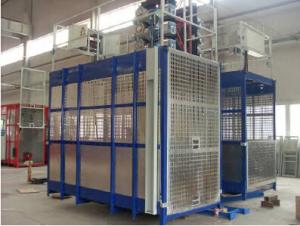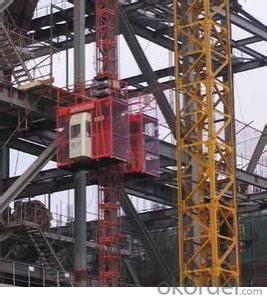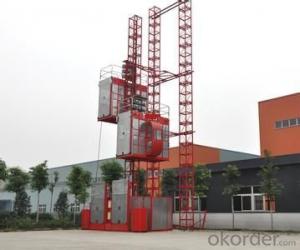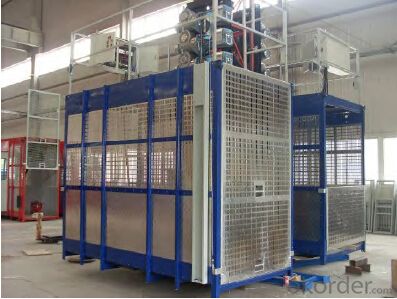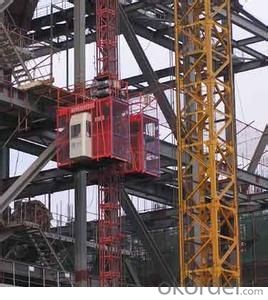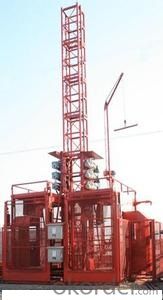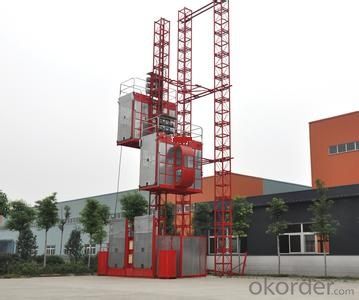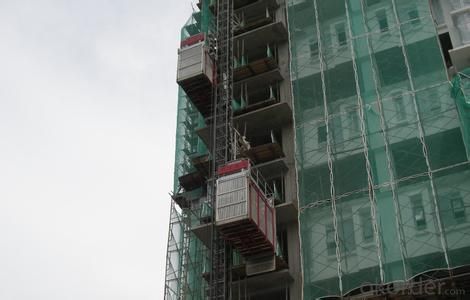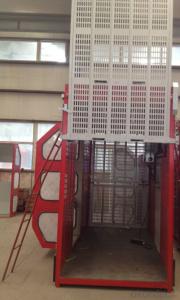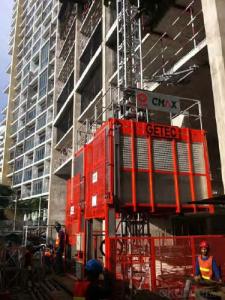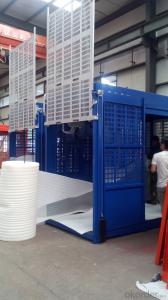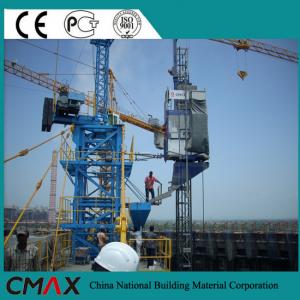Building hoist SC200/200, Reasonable Design, Novel Structure, Stable Operation
- Loading Port:
- Qingdao
- Payment Terms:
- TT or LC
- Min Order Qty:
- 1 set
- Supply Capability:
- 12 set/month
OKorder Service Pledge
OKorder Financial Service
You Might Also Like
SC Hoist is a Rack and Pinion EL. Lift, used on construction site for transportation of personnel and materials. It is installed and dismounted conveniently and can grow as high as the buildings grow in height.
There are single cage and twin cage hoists. A single cage can be quickly transformed into twin cage hoist by adding a cage and other parts. The hoist payload can be increased by adding counterweight equipment.
SC Hoist has reliable electrical and mechanical safety device. It is a efficient and safety vertical transporting equipment.
Main Parts of Building Hoist
SC200/200 construction elevator is a highperformance product which is newly researched, designed and launched by our company. The elevator features reasonable design, novel structure, stable operation, complete and reliable safety devices and convenient installation and maintenance, and mainly has the following characteristics:
1. The transmission mechanism is driven by two motors, and pinions and racks are safe and stable due to uniform stress.
2. To ensure the safe operation of the elevator, an overload switch, a speed limit switch and other safety switches are arranged in the circuit; when overload, speed limit and other conditions occur in the operation process, the elevator automatically prevents accidents at once. Each door on cages is provided with a limit switch; when any door is opened abnormally, all the cages cannot start or immediately stop operating.
3. Each cage is provided with an anti-falling safety device which can extremely effectively prevent the cages from falling and ensure the safe and reliable operation of the elevator.
4. The electric control system of the elevator has a simple circuit, is convenient to control and maintain and is reliable. When operating normally, the elevator can be controlled to operate by a handle or button in a cage, can be stopped at any time at any position needing the stop, and can be controlled to stop automatically by upper and lower terminal limit switches at upper and lower terminal stations. When the upper and lower terminal limit switches fail to act, limit switches additionally arranged on the elevator can cut off the power supply in time to stop it in a braking mode.
5. The steel structure adopts a computer-aided design mode and is scientifically and strictly calculated to meet the requirements of reasonable structure, reliable intensity and light weight.
6. The elevator can be self-mounted or make standard knots detached by using a hanger rod on a cage. All the other parts can be conveniently mounted and dismounted, and components are easy to replace.
Attached: construction elevator model compilation method
The model of the elevator consists of class, group, type, feature, main parameter and deformation codes.
Notes: The main parameter code includes rated loading capacity codes of two cages, for example, only one main parameter code is marked on a single cage.
Example 1: SCD120
Representing a pinion-and-rack construction elevator with a single cage, the rated loading capacity of 1,200Kg and counterweight
Example 2: SC200/200
Representing a pinion-and-rack construction elevator with double cages (each cage has the rated loading capacity of 2,000Kg) and no counterweight
Building Hoist Specifiction
Main technical data | Unit | Value |
Rated load | kg | 2×2000 |
Rated erection load | kg | 2×1000 |
Jib attachment rated load | kg | 300 |
Cage size | m | 3.0×1.3×2.5 |
Maximum lifting height | m | 250 |
Lifting speed | m/min | 33 |
Rated output | kW | 2×3×11 |
Voltage rating | V | 380/440 |
Rated frequency | Hz | 50/60 |
Rated current | A | 2×3×23.5 |
Power supply fuses | A | 2×96 |
Protective class | / | IP55 |
Load duration factor | / | FC-25% |
Safety device | m/s | 1.2 |
Enclosure weight | kg | 1480 |
Cage weight | kg | 2×1950 |
Counterweight | kg | / |
Mast section weight | kg | 150/170/190 |
Mast section length | mm | 1508 |
If you have special requirement on power, please state it when order the consignment.
We can produce the cage and lengthen the tie-in according to the size the customer requested.
We can heighten the erection height according to the customer’s request.
“/” means the item does not exist.
Building Hoist images
CMAX Building Hoist
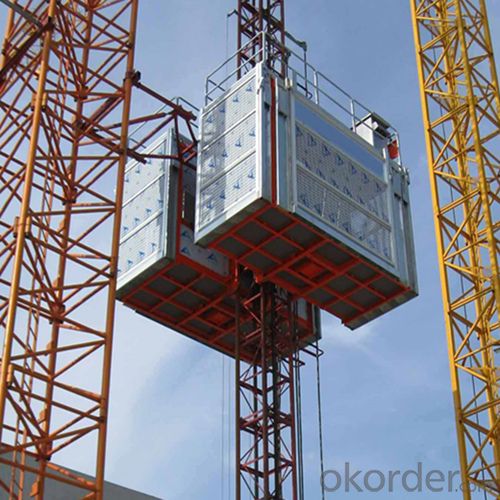
Anchorage System
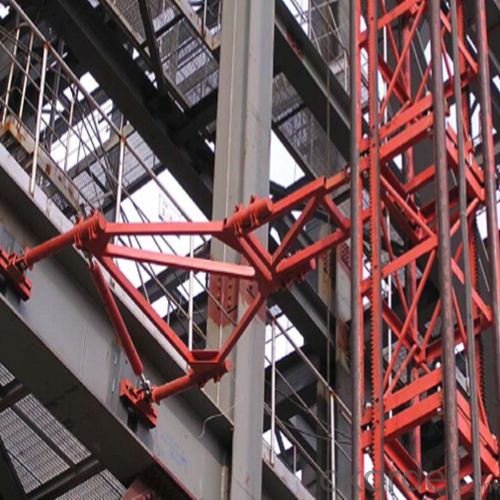
Driving Unit

Warehouse
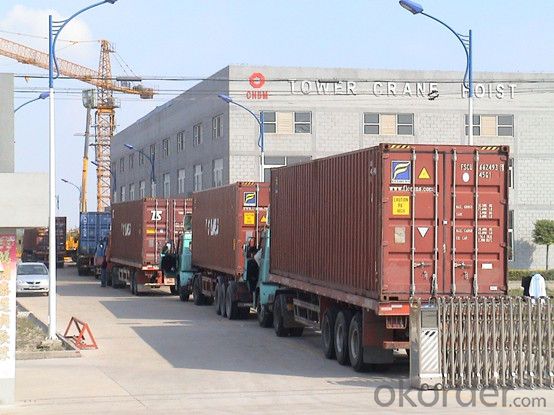
FAQ of Building Hoist
Q: What is the building hoist main purpose?
A: Building hoist equipped with double or single cabin to transport the materials and labors up and down. It's the ideal construction equipment for vertical transportation in the field of construction.
Q: What is the main structure of building hoist?
A: The P/M construction hoist mainly contains metal structure, driving system, electrical control system, cable guide & protection system, electrical top crane and safety device.
Q: What is the meaning of the building hoist’s code?
A: Take SC200/200 for example: “SC” stands for rack and pinion hoist, “200/200” stands for double cage and capacity is 2 tons per cage. “SC200” stands for single cage and capacity is 2 tons.
Q: What is the dimension of the cage?
A: Normally the cage dimension is 3X1.5X2.5M (L/W/H) for 2t type hoist. Details should be checked according to our quotation sheet. Also, the size can be customized according to the factual site condition. There are two doors (entrance & exit doors) for each cage, It can be produced as up & down sliding or ramping model for safety and convenience.
- Q: This question asks about the methods to ensure that lifting equipment is correctly positioned and functioning during its operation.
- <p>To ensure that lifting equipment is properly aligned during operation, follow these steps: 1. Conduct a thorough inspection before use, checking for any visible damage or misalignment. 2. Use precision measuring tools to verify the alignment of the equipment's components. 3. Adhere to the manufacturer's guidelines and specifications for alignment. 4. Regularly calibrate the equipment to maintain accuracy. 5. Train operators on proper alignment procedures and safety protocols. 6. Implement a maintenance schedule to address any alignment issues promptly. 7. Use load testing to confirm that the equipment can handle the intended load without misalignment. Proper alignment is crucial for safety and efficiency in lifting operations.</p>
- Q: The construction elevator can not operate during the use of several stages of wind power
- 11, when the wind speed exceeds 20m/s and the bad weather, such as hail, not use the lift." I'm a construction elevator This is the norm It's about a six-stage wind by 20m/s.
- Q: Can a building hoist experience technical issues or fail to operate properly?
- <p>Yes, a building hoist can malfunction. Like any mechanical system, hoists are subject to wear and tear, component failure, and can be affected by human error. Malfunctions may include mechanical breakdowns, electrical faults, or safety device failures. Regular maintenance, inspection, and adherence to safety protocols can reduce the risk of hoist malfunctions.</p>
- Q: A building hoist is a piece of equipment used in construction to lift materials and personnel.
- <p>A building hoist, also known as a construction hoist or material hoist, is a temporary lifting device used in the construction industry to transport materials, equipment, and sometimes personnel vertically within a building under construction. It is essential for efficient movement of heavy and bulky items, reducing manual labor and improving safety by minimizing the need for workers to climb ladders or handle heavy loads manually. These hoists are typically installed on the exterior of the building and are used throughout the construction process until the building's permanent elevators are installed and operational.</p>
- Q: This question asks for the steps or process involved in installing a building hoist, which is a type of crane used in construction to lift materials.
- <p>Installing a building hoist involves several steps: 1) Site preparation, ensuring the ground is level and strong enough to support the hoist. 2) Assembling the hoist tower, starting from the base and working upwards. 3) Installing the motor and drive system. 4) Attaching the cable and counterweight. 5) Rigging the hoist with safety devices and load limiters. 6) Conducting a thorough inspection and testing the hoist for safety and functionality. 7) Obtaining any necessary permits and approvals. It's crucial to follow the manufacturer's instructions and local regulations, and often requires a professional team for safe and proper installation.</p>
- Q: What is the height of protecting door protection of construction elevator
- Referring to the unified code of construction safety technology of GB 50870-2013, and the construction safety inspection standard JGJ59-2011
- Q: Is it feasible to utilize a building hoist for lifting heavy objects when the ground is not level?
- <p>A building hoist is generally designed for vertical lifting in a stable and level environment. Using it on uneven ground can be hazardous and is not recommended due to the risk of tipping or instability. For lifting heavy objects on uneven ground, it's advisable to use specialized equipment like mobile cranes or all-terrain forklifts that are designed to handle such conditions. Always consult the manufacturer's guidelines and safety regulations before using any lifting equipment.</p>
- Q: What precautions should be taken on construction sites when operating a building hoist?
- <p>Safety measures for using a building hoist in construction sites include regular inspections and maintenance to ensure the hoist is in good working condition. Operators must be trained and certified to use the hoist. Safety barriers or gates should be installed to prevent unauthorized access. Load limits must be strictly adhered to, and overloading is prohibited. Emergency stop buttons should be easily accessible. Workers should wear appropriate personal protective equipment (PPE). Regular safety briefings and training sessions should be conducted to keep workers informed about safe hoist operation procedures.</p>
- Q: This question asks for a comparison of the benefits and drawbacks associated with the use of hydraulic lifting equipment.
- <p>Hydraulic lifting equipment offers several advantages, including high force generation, compact design, and precise control. It is energy-efficient and can handle heavy loads with ease. The systems are also known for their durability and low maintenance requirements. However, there are disadvantages such as sensitivity to leaks and the need for regular fluid checks. They can be complex to install and maintain, and the equipment can be costly. Additionally, hydraulic systems are sensitive to temperature changes, which can affect performance.</p>
- Q: This question asks if a building hoist can be utilized in both commercial and residential settings.
- <p>Yes, a building hoist can be used for both commercial and residential purposes. These hoists are designed to lift materials and workers to various levels of construction sites. In commercial settings, they are often used in the construction of office buildings, shopping centers, and other large-scale projects. In residential construction, they are used for multi-story apartment buildings or private homes. It's important to note that the specific type and capacity of the hoist should be suitable for the scale and requirements of the project to ensure safety and efficiency.</p>
Send your message to us
Building hoist SC200/200, Reasonable Design, Novel Structure, Stable Operation
- Loading Port:
- Qingdao
- Payment Terms:
- TT or LC
- Min Order Qty:
- 1 set
- Supply Capability:
- 12 set/month
OKorder Service Pledge
OKorder Financial Service
Similar products
Hot products
Hot Searches
Related keywords
